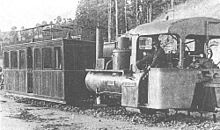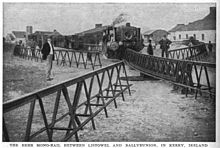- Lartigue Monorail
-
The Lartigue Monorail system was developed by the French engineer Charles Lartigue (1834–1907). He developed a horse drawn monorail system invented by Henry Robinson Palmer in 1821 further.[citation needed]
The most famous Lartigue railway was the Listowel and Ballybunion Railway in Ireland.
Lartigue had seen camels in Algeria carrying heavy loads balanced in panniers on their backs. This inspired him to design a new type of railway. Instead of the conventional two parallel rails on the ground, it had a single rail sitting above the sand and held at waist height on A-shaped trestles. The carriages sat astride the trestles like panniers.
By 1881 Lartigue had built a 90 km monorail to transport esparto grass across the Algerian desert, with mules pulling trains of panniers that straddled the elevated rail.
However the Lartigue system as built was not truly a monorail, since it was necessary to add two further rails on each side, lower down the A frames. These did not carry any weight, but unpowered stabilising wheels fitted to all the engines and wagons contacted these extra rails to prevent the vehicles from overbalancing.
Contents
The Listowel and Ballybunion Railway
This was a 14.4-km (9-mi) monorail built on the Lartigue principle in County Kerry in Ireland. It linked Listowel and Ballybunion, and opened on 29 February 1888.[1]
The locomotives were of the 0-6-0 type (strictly speaking, 0-3-0), constructed by the Hunslet Engine Company. They were specially built with two boilers in order to balance on the track, and consequently two fireboxes, one of which had to be stoked by the driver. They were also fitted with powered tenders for auxiliary use on hills. The tender wheels were driven by two cylinders via spur gears. Two small chimneys were fitted to each tender to discharge the exhaust steam from these cylinders. A smaller engine nicknamed the "coffee pot" was said to have been used during the railway's construction, but there is no photographic evidence to support this.
Loads had to be evenly balanced. If a farmer wanted to send a cow to market, he would have to send two calves to balance it, which would travel back on opposite sides of the same freight wagon, thereby balancing each other.[2]
Another problem with using the Lartigue system in populated areas was that, due to the track's design, it was not possible to build level crossings. In order for a road to cross the track, a kind of double-sided drawbridge had to be constructed, which required an attendant to operate it. Where farmers' tracks crossed the line there were level crossings based on the principle of a turntable. These were locked and the farmer in question provided with a key. Once unlocked the track could be swivelled to one side to allow the crossing to be used. Both the swivelling and drawbridge type crossings were automatically linked to signals which stopped any approaching trains; road traffic was always given priority under this system.
Passengers could not pass from one side of a carriage to another while in motion. A kind of footbridge was built into one end of some of the passenger coaches, while at least one such bridge was carried on a separate wagon. This allowed passengers to cross from one side of the line to the other while the train was stopped at a station.
Conventional railway points could not be used, so a similar function was fulfilled by a large number of turntables.
The line closed in 1924 after the track was damaged during the Irish Civil War, and everything was scrapped except a short section of the track.
Restoration
In 2003 the Lartigue Monorailway Restoration Committee, a voluntary organisation from Listowel, opened a 1000 metre section of Lartigue monorail on the trackbed of the former North Kerry line in Listowel. The line is worked by a diesel locomotive built to resemble the original 0-3-0 steam engines. The locomotive and its train of replica coaches were built by Alan Keef Ltd.[3]
See also
References
- ^ Guerin, Michael (1988). The Lartigue: Listowel and Ballybunion Railway. Listowel: Lartigue Centenary Committee. ISBN 0-9513549-0-6.
- ^ Sekon, G. A. (November 1924). The Railway Magazine (London).
- ^ "Listowel and Ballybunion Railway". http://www.lartiguemonorail.com/index.php.
Further reading
- Newham, A.T. (1998) [1989]. The Listowel and Ballybunion Railway (LP33 ed.). Oakwood Press. ISBN 0-85361-093-2.
- The Graphic (January): 61. 1887.
External links
- The Rebuilt Lartigue Monorailway website
- Lartigue railway photos (2004)
- The Lartigue System at The Museum of Retrotech
- The Lartigue Monorailway Photos
- Eiretrains - Lartigue Railway at Lisselton
Heritage railways and preservation societies in the Republic of Ireland Cavan and Leitrim Railway · Clonmacnoise and West Offaly Railway · Donegal Railway Centre · Irish Steam Preservation Society · Irish Traction Group · Lartigue Monorail · Railway Preservation Society of Ireland · Tralee and Dingle Light Railway · West Clare Railway
Heritage Railways: Northern Ireland ·
Republic of IrelandCategories:- Heritage railways in the Republic of Ireland
- Alternatives to conventional railways
- Rail transport in Ireland
- Monorails
Wikimedia Foundation. 2010.




